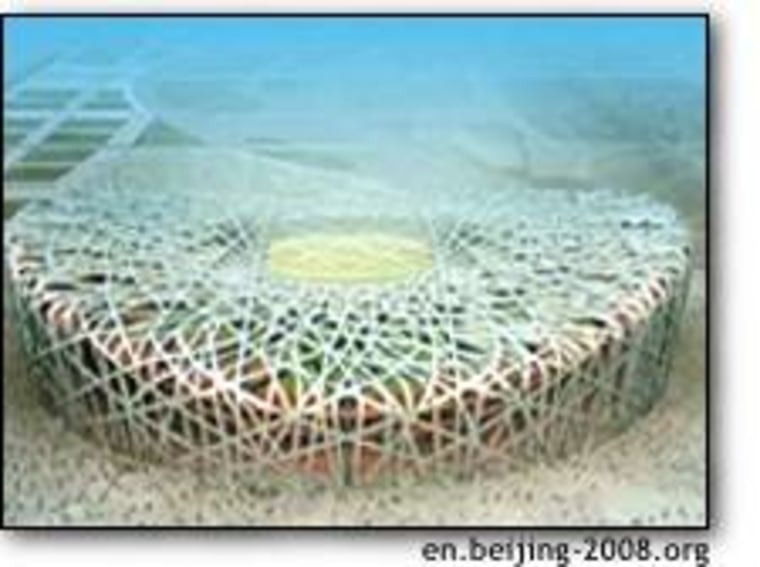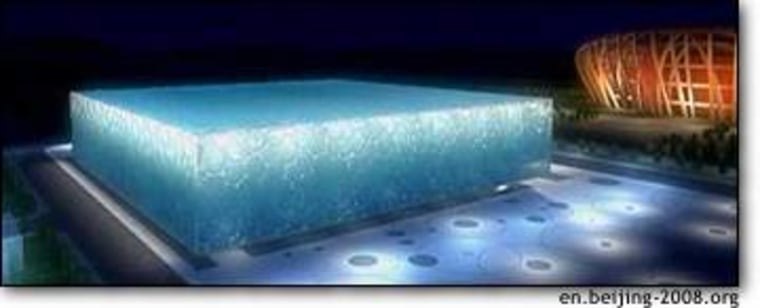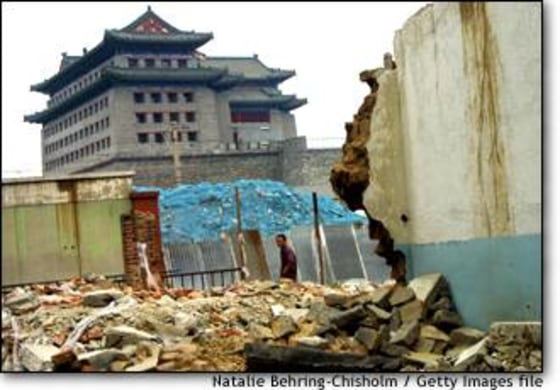By the time the Olympic torch arrives in Beijing in 2008, the Chinese capital will be completely transformed into a pollution-free, green, efficient city filled with brand new top-of-the-line sports venues — at least, so said Chinese Olympic organizers at a business conference in Seattle. Here’s the part the audience heard most clearly: $26 billion worth of contracts will be doled out over the coming four years to make it happen. “The magnitude is absolutely enormous,” said Washington’s governor, Gary Locke, told the audience. “We’re seizing the opportunity.”
One thing is plain: Beijing really is committed to investing a vast amount of money to build sports facilities, upgrade transportation and communication in the city, ensure that there is a clean water supply, and build up all the security and services that are required to host the Olympic Games.
Among the big ticket items on the construction agenda are a national stadium ($360 million), a swimming center ($100 million), the Olympic village ($400 million), a convention center ($254 million) and an equestrian park ($128 million).
But many millions more will be plunged into expanding wireless telecommunications, a new airport, extension of subway lines, waste treatment facilities, road construction, landscaping and air pollution control.
The vision combines grandiose communist planning with capitalist allure.

“By 2005, we will basically solve the problem of air pollution and traffic jams,” Zhu Peifen, chief of the foreign investment and trade division for Beijing planning, told the Seattle gathering Wednesday. Foreign companies are welcome to be partners in these projects, she said, adding cheerfully, “And of course, make money!”
Potential for badly needed urban housing is “unfathomable” said William Karst, the CEO of Callison Architecture, who says there are residential construction opportunities connected to nearly all projects. In addition, there are entertainment, tourism and other facilities to take on in connection with the Olympics.
“There are no small projects in China,” Karst says. “One million square feet is small, 5 million square feet is medium, and 10 million square feet is large.”
Turning a new leaf?
The enthusiasm about China’s potential is not new. For decades, businesses have hungrily eyed the Chinese market and invested billions of dollars there, chasing the dream of its 1 billion consumers. It has not been a failure, but extremely slow going for most companies, as China only gradually removes restrictions and biases against foreign companies operating there.
Companies that have invested in manufacturing in China, taking advantage of lower labor costs to produce goods for export to the United States and elsewhere have thrived. But gaining a toehold to sell goods and services in the Chinese market has been far more challenging. This is one reason the United States’ trade deficit with China soared to $100 billion in 2002, a fivefold increase from 1992, surpassing Japan as the leading contributor to the gap.

But the Olympic run-up could mark a turning point. Experts note that China’s accession to the World Trade Organization at the start of 2002 has hastened long-awaited reforms, leveling the playing field in areas such as construction and easing restrictions on technology imports.
At the same time, notes David Hind of Qualcomm, China is promising open bidding on all its projects, and demands open bidding for all subcontracting and materials related to the Olympics — a decided shift in the way business has long been done. China also has a new government with younger leaders ushered in within the last year.
“It’s real and it’s huge,” says Hind, who spoke to the Seattle conference about technology opportunities. His telecommunications company has 150 staff members in China, compared to five employees three years ago. Growth in wireless telecommunications has grown so fast it surpassed the use of land lines last year.
Of the 150 companies at the conference, some already have a substantial presence in China — Microsoft, Boeing, Weyerhauser and Nike — and some also have a history of providing services for previous Olympic Games. Quality Technology, whose representatives came from headquarters in San Diego, expect to be vying for large security contracts similar to those they signed for the Salt Lake and Athens Olympic Games. Terabeam, a telecommunications company that provided technology used in the broadcast of television signals from the Sydney Olympics, was hoping to capitalize on that experience to win 2008 Olympics business.
Climate concerns
Whether these players get in on contracts, however, is still an open question.
“It’s not a sham,” says Robert Kapp, president of the U.S.-China Business Council who says U.S. businesses view the Olympics as a serious opportunity. “There are a zillion possibilities for foreign companies, not only American … to sell their services for the Olympics.”
But he also notes that China could face political pressure to buy domestically. “Whether or not China will move to source their materials internationally, or make extreme efforts to give these opportunities to domestic companies remains to be seen,” he says.
Additionally, there is international frustration with China’s failure to allow its currency to float. By keeping it artificially low, China’s foreign critics say it makes imports more expensive, thus less attractive.
And even in a non-democratic country, there are critics of Olympics spending and pressures on the government to be prudent. While it was forced by the IOC to spend more on security measures, in July Beijing canceled construction of several facilities — including a tennis center and a hockey facility, worth a total of $180 million.
In the initial phase of bidding on major Olympics-related projects, a handful of contracts have been awarded.
Design work for Olympic Stadium, a 100,000 seat facility with a retractable roof at the heart of the Beijing Games, went to a Swiss-British-Chinese consortium including internationally acclaimed Swiss firm Herzog & de Mueron Architekten.
The construction of the 70,000 square-foot, 17,000-seat “Watercube” swimming center was awarded to a Sino-Australian joint venture. The building’s skin is to be made from a transparent Teflon surface that will filter light and trap solar energy. One of the two Australian companies involved, Ove Arup Pty. Ltd., also designed the swimming center.
A Malaysian company was chosen to build, in partnership with a Chinese company, a new sewage treatment plant in Beijing, as part of 2008 Games preparations.
